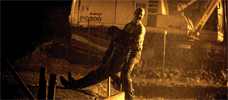Reviews
Joel Anderson
Australia, 2008
Credits
Review by Rumsey Taylor
Posted on 17 March 2009
Source 35mm print
Categories The 2009 South by Southwest Film Festival
Lake Mungo concerns the loss of Alice Palmer, a bright, well-to-do, beautiful 16-year-old girl in Ararat, Australia. Her family describes her with defeated, simple descriptions: she was a bright, well-to-do, beautiful 16-year-old. Essentially all you need to know about her is her philanthropic beauty, inspiring good will, and comfort to others by being generally nice and smiling. When her mangled corpse is extracted from the location of the title, her beauty has been violently taken away. It’s here that the film’s horror is first established, with rigid adherence to horror customs— even Alice’s name evokes Laura Palmer in Twin Peaks, and like Laura she too has violent secrets. I understand that this is a sort of cinematic shorthand; the film quickly and broadly establishes this girl and her family’s blandly perfect love for her, and in making the character young, well-to-do, and unassailably attractive forgoes having to describe anything else about her personality. She is dead because she would have been a less engaging character alive.
The film endeavors to create an atmosphere of quiet, uncertain remorse, and it succeeds at this early on. Alice’s absence is something her family is initially and unreasonably skeptical of, even though a body is found and buried; it feels like Alice is still around, but instead of assuaging her family’s grief, she remains an invisible menace. The family describe the noises they hear at night in their house, suspecting that their daughter’s ghost is somehow present. Her brother, an amateur photographer and videographer, sets up cameras to run overnight, and inevitably they capture something venturing ambiguously through the passages in the middle of the night.
This revelation is depicted like so: the evidential footage is shown— an aural shriek accompanying the discovery of a shape that is possibly Alice’s ghost— and then the footage is repeated in slow motion, the composition enclosing the grainy shape of a pubescent female body. This happens over a dozen times in Lake Mungo, effectively deflating whatever suspense the film aspires to create in each subsequent and nearly identical revelation of Alice’s pixellated ghost.
It is revealed that the brother, as an act of grieving, manufactured the images of his deceased sister as a means of purging his family’s grief. But inevitably the ghostly images persist, even though he is no longer responsible for them. At this point, roughly two-thirds through, Lake Mungo has contradicted itself by establishing that these images are deceptive, and then insisting that the viewer betray this knowledge and continue to see ghosts in the grainy photos and video footage. The film conditions you to doubt, growing less suspenseful, less atmospheric, and less frightening as it progresses. It is by design an anticlimactic film, a jack-in-the-box that operates reliably at scheduled intervals.
More The 2009 South by Southwest Film Festival
-

The Square
2008 -

Objectified
2009 -

Lake Mungo
2008 -

Alexander the Last
2009 -

Beeswax
2009 -

Troll 2
1990 -

Best Worst Movie
2009 -

Three Blind Mice
2009 -

Make-Out with Violence
2008 -

We Live in Public
2009 -

Modern Love is Automatic
2009
We don’t do comments anymore, but you may contact us here or find us on Twitter or Facebook.



